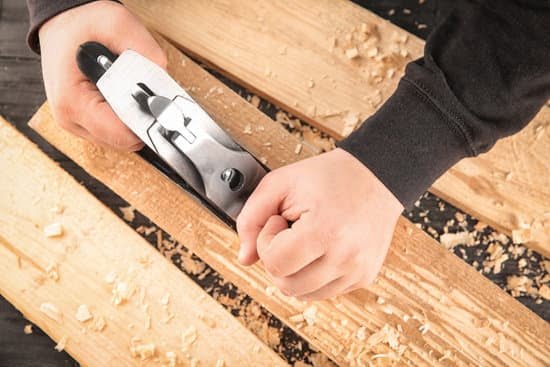Woodworking is a captivating and fulfilling hobby that allows individuals to tap into their creativity while also producing practical and beautiful pieces. However, many people assume that woodworking requires a large workshop and outdoor space, making it impossible for apartment dwellers to pursue this craft. In reality, woodworking can be successfully practiced within the confines of an apartment, and this article will guide you on how to get started.
In this introductory section, we will address common misconceptions about woodworking in small spaces and highlight the benefits of pursuing this craft in an apartment setting. Despite the limited square footage, apartments offer unique advantages such as proximity to inspiration and convenience. By embracing innovative techniques, compact tools, and creative organization methods, anyone can create an effective woodworking space within their apartment walls.
Throughout the article, we will delve into various aspects of apartment woodworking. We will discuss choosing the right tools that are suitable for limited space and recommend practical alternatives to traditional tools.
Additionally, we will explore how to set up a functional workspace by maximizing limited room for woodworking activities and suggesting storage solutions for tools and materials. We’ll also address concerns about noise levels and dust management in an apartment environment while emphasizing safety precautions unique to apartment woodworking.
Though challenges may arise when embarking on any new journey, learning resources and online communities serve as valuable support systems for apartment woodworkers. We will introduce reputable tutorials, courses, blogs, and forums where beginners can gather knowledge from experienced woodworkers while finding guidance and inspiration from a virtual community of fellow enthusiasts.
Stay tuned as we dive into creative woodworking projects specifically designed for small spaces. From space-saving furniture to adaptable decor projects, these ideas will spark your imagination while accommodating your living situation. Furthermore, we will address common challenges faced by apartment woodworkers alongside practical solutions that have been proven successful.
Woodworking should not be limited by one’s living arrangements; with proper guidance and resourcefulness, anyone can pursue this hobby within an apartment’s constraints. Embrace the possibilities, and let’s embark on this woodworking journey together.
Choosing the Right Tools for Apartment Woodworking
When it comes to woodworking in an apartment, choosing the right tools is essential. However, with limited space, it’s important to prioritize compact and multifunctional tools that can still deliver excellent results. Here are some recommendations for essential tools that are perfect for beginners in small spaces:
Compact Circular Saw
A circular saw is a versatile tool for making straight cuts, and a compact version is ideal for apartment woodworking. Look for a lightweight and easy-to-handle model that offers precise cutting capabilities.
Benchtop Planer
A benchtop planer is a must-have tool for achieving smooth and even surfaces on your woodworking projects. Opt for a smaller model that can fit on a tabletop or workbench without taking up too much space.
Pocket Hole Jig
Joinery plays a significant role in woodworking projects, and a pocket hole jig makes it easier to create strong and seamless connections between pieces of wood. Choose a compact pocket hole jig that can be easily stored when not in use.
A brad nailer
A brad nailer is an invaluable tool for attaching trim pieces or securing joints quickly and efficiently. Look for a cordless model to avoid dealing with cords in your limited workspace.
Multi-Tool
Investing in a multi-tool is highly recommended because it combines various functions into one handheld device. A multi-tool typically includes features like sanding, cutting, scraping, and more – perfect for small-space woodworking.
Remember, quality matters when it comes to tools. Investing in high-quality tools ensures better performance, longevity, and overall satisfaction with your woodworking projects. While they may come with a higher price tag initially, they will save you money in the long run by delivering superior results and requiring less maintenance or replacement.
Additionally, consider investing in space-saving storage solutions to keep your tools organized and easily accessible. Wall-mounted tool racks, magnetic strips for storing metal tools, and portable toolboxes can all help maximize your limited workspace.
By choosing the right tools and organizing your workspace effectively, you can embark on your woodworking journey in an apartment without compromising on quality or creativity.
Setting up a Workspace in Your Apartment
Woodworking requires a dedicated workspace where you can unleash your creativity and bring your projects to life. When working with limited space in an apartment, setting up an efficient and organized workshop can be a challenge. However, with some careful planning and creativity, it is possible to create a functional workspace that meets your woodworking needs.
Maximizing limited space for woodworking activities:
When space is limited, it’s crucial to utilize every square inch efficiently. Consider the following tips to make the most of your apartment workshop:
Multi-purpose furniture
Look for furniture pieces that can serve as both storage and work surfaces. For example, a sturdy workbench with built-in drawers can provide ample storage for tools and materials while also serving as a workspace. Additionally, furniture with foldable or adjustable components can help optimize the available space.
Wall-mounted storage
Make use of vertical space by installing wall-mounted shelves or pegboards to store and display your tools. This not only keeps them within easy reach but also frees up valuable floor space.
Mobile workstation
Consider investing in a portable workbench or cart that can be easily moved around your apartment when needed. This allows you to adapt your workspace based on the size of the project at hand.
Creative storage solutions for tools and materials:
In small living spaces, finding creative storage solutions is key to maintaining an organized workshop. Here are some ideas to help you keep your tools and materials accessible yet neatly tucked away:
Tool organizers
Utilize magnetic strips or wooden racks mounted on walls to hold frequently used hand tools like chisels, screwdrivers, and wrenches. Compact toolboxes with compartments can also keep smaller tools organized and easily transportable.
Materials storage
Optimize limited space by storing lumber and other materials vertically. Use wall-mounted racks or sturdy hooks to keep your wood pieces organized and off the floor.
Utilize underutilized spaces
Take advantage of underutilized spaces such as the back of doors or inside closet doors for additional storage. Install racks, hooks, or small shelves to hold items like clamps, sandpaper, and safety gear.
Tips for maintaining a functional and organized workshop within an apartment:
Keeping your apartment workshop functional and organized is essential for productivity and safety. Consider the following tips to maintain an efficient workspace:
Clean as you go
Woodworking tends to generate debris and sawdust that can quickly clutter your space. Make it a habit to clean up after each work session to maintain a clean and safe working environment.
Categorize and label
Keep your tools, fasteners, and materials categorized by type and size. Labeling drawers, bins, or storage compartments will help you locate items quickly when you need them most.
Prioritize safety
Ensure your workshop has ample lighting for visibility during woodworking tasks. Invest in a fire extinguisher suitable for woodworking projects and place it in a readily accessible spot. Additionally, implement safety protocols such as wearing appropriate personal protective equipment (PPE) like safety glasses and ear protection.
By maximizing limited space, employing creative storage solutions, and maintaining an organized workshop, you can create a functional woodworking workspace in your apartment. With these tips in mind, you’ll be well on your way to enjoying the rewarding world of woodworking while residing in an apartment setting.
Noise and Dust Management in Apartment Woodworking
Woodworking often involves the use of power tools that can create noise and generate significant amounts of dust. These factors can be particularly challenging for apartment dwellers who must be mindful of their neighbors and the impact of sawdust within their living space. However, with careful planning and the right strategies, it is possible to effectively manage noise and dust while pursuing woodworking in an apartment.
Noise levels are a common concern when it comes to woodworking in small spaces. To minimize noise disturbances, it is advisable to invest in quiet tools and equipment options.
For example, choosing a portable table saw with built-in insulation or using a router with a sound-reducing base can significantly reduce noise levels without compromising on functionality. Additionally, incorporating sound-dampening materials such as foam or rubber pads under workbenches and tool bases can further help absorb vibrations and minimize noise.
| Tool | Noise Level (dB) |
|---|---|
| Traditional Table Saw | 95 dB |
| Portable Table Saw with Built-in Insulation | 85 dB |
Another critical aspect of managing noise in an apartment woodworking setup is being mindful of the time you choose to work on your projects. Consider working during daytime hours when there is less likelihood of disturbing your neighbors. Additionally, it may be helpful to inform your neighbors about your hobby and establish open lines of communication to address any concerns they may have.
Dust management is equally important when woodworking in an apartment setting. Regular exposure to wood dust can pose health risks, so it’s essential to take measures to control its spread.
Using tools equipped with built-in dust collection systems or attaching a dust extractor to your power tools can effectively capture and contain the majority of sawdust. It’s also important to wear personal protective equipment, such as a dust mask and safety goggles, to minimize inhalation and eye exposure to fine particles.
Overall, managing noise and dust in apartment woodworking requires careful consideration and planning. By investing in quiet tools, being mindful of working hours, utilizing dust collection systems, and wearing appropriate safety gear, woodworkers can create a conducive environment for their hobby while respecting their neighbors and maintaining a clean living space.
Safety Precautions for Apartment Woodworking
Woodworking is a fulfilling hobby that can be enjoyed in any space, including apartments. However, it’s important to prioritize safety when engaging in woodworking activities within the confines of an apartment. This section will highlight some safety precautions that are essential for apartment woodworkers to ensure a safe and enjoyable experience.
Ventilation and Fire Safety Protocols
In an apartment setting, proper ventilation is crucial when working with wood and various finishing materials. Ensure that your workspace has adequate airflow by opening windows or using fans to maintain fresh air circulation. Additionally, be cautious of the potential fire hazards associated with woodworking. Keep flammable materials separate and away from heat sources such as power tools, soldering irons, or open flames. Make sure you have a fire extinguisher readily available and know how to use it effectively.
Proper Storage and Handling of Hazardous Materials
When working on woodworking projects, it’s common to use certain materials that may pose health risks if not handled properly. Solvents, stains, paints, and varnishes can contain volatile organic compounds (VOCs) that may be harmful when inhaled or come into contact with skin. Store these materials in a well-ventilated area away from living spaces and always follow the manufacturer’s instructions for storage and handling.
Personal Protective Equipment (PPE)
Investing in appropriate personal protective equipment (PPE) is essential for apartment woodworkers to minimize the risk of accidents or injuries. Safety glasses should be worn at all times while operating power tools or when there is a chance of flying debris. Dust masks or respirators are necessary to protect against inhalation of sawdust or harmful chemicals present in finishing products. Additionally, gloves can provide added protection from sharp tools or splinters.
By following these safety precautions, apartment woodworkers can create a secure environment for their woodworking activities. Remember, safety should always be the top priority to ensure an enjoyable and injury-free experience.
Learning Resources and Online Communities for Apartment Woodworkers
For apartment dwellers interested in woodworking, there is a wealth of learning resources and online communities available to support their journey. These resources provide guidance, inspiration, and opportunities for collaboration with fellow woodworkers in similar living situations. Whether you are a beginner looking to learn the basics or an experienced woodworker seeking new techniques and project ideas, these online platforms can be invaluable.
One popular option for learning woodworking skills is through online tutorials and courses. Reputable websites such as Udemy, Skillshare, and YouTube offer a wide range of classes taught by experienced woodworkers. These courses cover various topics including tool usage, joinery techniques, furniture making, and more.
They often provide step-by-step instructions that make it easy for beginners to follow along and progress at their own pace. Additionally, many of these platforms offer forums or discussion boards where learners can interact with instructors and fellow students to ask questions or seek feedback on their projects.
In addition to formal courses, virtual woodworking communities are also emerging as valuable resources for apartment woodworkers. Platforms like Reddit’s /r/woodworking subreddit or woodworking-specific forums like Sawmill Creek provide spaces for woodworkers to share their projects, ask questions, seek advice, and engage in discussions about all things woodworking. These communities create connections among woodworkers who may not have access to traditional workshop spaces but still want to connect with others who share their passion.
Finding an online community that aligns with your woodworking interests can help foster a sense of camaraderie and provide inspiration when embarking on new projects. It allows woodworkers to learn from each other’s experiences and gain insights into different techniques or approaches. By actively participating in these communities, apartment woodworkers can build a network of like-minded individuals who can offer support along their woodworking journey.
| Learning Resources | Online Communities |
|---|---|
| Udemy | /r/woodworking subreddit |
| Skillshare | Sawmill Creek forum |
| YouTube tutorials | Woodworking Talk forum |
Creative Woodworking Projects for Apartment Dwellers
One of the great aspects of woodworking is the ability to create beautiful and functional pieces for your home. And just because you live in an apartment doesn’t mean you can’t enjoy this aspect of the craft. In fact, there are many creative woodworking projects that are perfect for apartment dwellers. These projects not only allow you to showcase your skills as a woodworker but also provide practical solutions for maximizing space in smaller living areas.
One popular project idea for apartment woodworkers is creating multipurpose furniture pieces. For example, you could build a coffee table with built-in storage compartments or a TV stand with shelves and drawers. These types of pieces serve a dual purpose by providing both storage and functionality, making them ideal for apartments where space is limited.
Another creative project idea is designing and building small-scale decor items. Consider creating floating shelves to display plants or books, or crafting a unique wall-mounted key holder. These smaller projects not only add a personal touch to your living space but also allow you to experiment with different woodworking techniques and designs.
Additionally, unlike larger woodworking projects like cabinets or large-scale furnishings, these smaller projects can typically be completed within a shorter timeframe. This makes them more manageable for apartment dwellers who may have limited time or resources.
When embarking on these creative woodworking projects, remember to choose materials wisely. Opting for lightweight yet durable woods like pine or plywood can make handling and transporting the finished piece easier. Additionally, consider using finishes that are low-odor and easy to apply in order to minimize any potential disturbances from fumes within your apartment.
Embracing creative woodworking projects as an apartment dweller allows you to customize your living space while honing your skills as a woodworker. Don’t let limited space hold you back – unleash your creativity and start building beautiful pieces that reflect your personality and style.
Overcoming Challenges and Celebrating Success in Apartment Woodworking
Woodworking in an apartment setting comes with its own set of challenges, but with the right mindset and strategies, you can overcome these obstacles and find success in your woodworking endeavors. In this section, we will address some common challenges faced by apartment woodworkers and offer practical solutions to help you navigate through them.
One common challenge is limited space. Apartments typically have smaller footprints compared to standalone workshops or garages, but that doesn’t mean you can’t create a functional workspace. One key tip is to maximize vertical space. Consider installing wall-mounted shelves or pegboards to store your tools and keep them organized. Another option is investing in compact and multi-functional tools that save on space without compromising functionality.
Another challenge is noise management. Living in close quarters with neighbors means being mindful of the noise levels generated during woodworking activities. To mitigate this issue, opt for quieter tools and equipment. For example, there are many quiet handheld power tools available on the market that produce less noise compared to their larger counterparts. Additionally, consider using noise-dampening materials such as foam or rubber mats under your workbench to minimize vibrations and sound transmission.
Controlling sawdust is another important aspect of apartment woodworking. Sawdust can accumulate quickly in a small space, leading to potential health hazards and cleanliness issues. To address this challenge, invest in a high-quality dust collection system that effectively captures sawdust at the source. Alternatively, use portable dust extractors during your woodworking sessions or consider setting up a temporary outdoor workspace for activities generating excessive amounts of sawdust.
While there may be challenges associated with woodworking in an apartment, it’s important to celebrate the successes along the way. Hearing positive stories from other apartment woodworkers can provide inspiration and motivation for overcoming any hurdles you encounter. Take advantage of online communities dedicated to apartment woodworking where you can connect with fellow enthusiasts, share your progress, seek feedback, and learn from others’ experiences.
By acknowledging and finding solutions to the challenges, apartment woodworking can be a rewarding and fulfilling hobby. Don’t let limited space deter you from pursuing your passion for woodworking. With creativity, adaptability, and the right resources, you can create beautiful projects right in the comfort of your own apartment.
Conclusion
Woodworking is a rewarding and fulfilling hobby that can bring immense satisfaction and pride to apartment residents. Despite common misconceptions about limited space, apartment woodworking offers numerous benefits and possibilities.
By choosing the right tools for apartment woodworking, setting up a functional workspace within limited space, managing noise and dust, prioritizing safety precautions, utilizing learning resources and online communities, exploring creative projects specifically designed for small spaces, and overcoming challenges with practical solutions, apartment dwellers can fully embrace woodworking as a meaningful hobby.
Whether you are a beginner or an experienced woodworker looking to downsize or adapt to apartment living, there are plenty of options available for creating in smaller spaces. By selecting compact alternatives for traditional woodworking tools and investing in quality equipment, you can effectively pursue your woodworking projects without compromising on craftsmanship.
It is essential to maximize your limited space by utilizing creative storage solutions and maintaining an organized workshop. Additionally, addressing concerns about noise levels and controlling sawdust are crucial considerations for harmonious living in an apartment.
Safety should always be a top priority when engaging in woodworking activities within an apartment setting. Understanding the unique safety measures specific to apartment woodworking such as ventilation protocols and proper handling of hazardous materials is important. Embracing learning resources, online tutorials, courses, and virtual woodworking communities can provide invaluable guidance and inspiration along the way. These platforms also offer opportunities for sharing progress and seeking feedback from fellow woodworkers.
Ultimately, embracing woodworking as an apartment resident is accessible and adaptable to any space. By exploring creative projects designed specifically for small spaces such as space-saving furniture or decor pieces, you can showcase your skills while maximizing functionality within your living environment. It is important to remember that challenges may arise but with practical solutions and perseverance, success stories abound in the world of apartment woodworkers.
So go ahead-take the leap into woodworking in your apartment. The rewards are boundless: the fulfillment of creating something with your own hands, the ability to customize your living space, and the joy of engaging in a hobby that can be as practical or artistic as you desire. Embrace the accessibility and adaptability of apartment woodworking and witness the transformation of your living space into a haven of creativity and craftsmanship.
Frequently Asked Questions
How do I get into woodworking if I live in an apartment?
Living in an apartment should not deter you from getting into woodworking. While space may be limited, there are still ways to pursue this hobby. Firstly, consider investing in portable and compact tools that can be easily stored away when not in use. Look for a sturdy workbench or table that can fit in a corner or against a wall.
To minimize noise and dust, set up your woodworking station on a balcony or patio if available. Utilize protective mats or drop cloths to protect the floor from any accidental spills or scratches. Keep your materials and supplies organized in storage bins or cabinets to maximize the limited space you have. Lastly, consider joining a local woodworking club or community center that may offer access to shared workshop spaces with larger equipment.
How do I get into woodworking with no experience?
Starting woodworking with no experience requires only enthusiasm and a willingness to learn. Begin by familiarizing yourself with the basic concepts of woodworking through online resources, books, or instructional videos. Since safety is paramount, educate yourself about proper handling and usage of tools before starting any projects.
To gain hands-on experience, consider attending beginner classes or workshops offered by local craft centers, vocational schools, or community colleges. These will provide guidance on essential techniques while offering access to tools and equipment you may not have at home initially. Practice patience and start with small projects like building simple shelves or stools before gradually progressing to more complex pieces.
How do I get into basic woodworking?
Beginning basic woodworking involves mastering fundamental skills and acquiring necessary tools. Start by building a collection of essential hand tools such as a tape measure, chisels, hand saws (e.g., rip saws and crosscut saws), planes (block plane & smoothing plane), clamps, marking gauges, and squares (combination square and try square). These tools will allow you to tackle various tasks efficiently.
Once equipped, practice measuring accurately, cutting straight lines using hand saws, planing surfaces flat & smooth textures effectively using planes, fastening joints using clamps, and marking precise angles using squares. It is also crucial to learn about different types of wood and their properties to understand which is best suited for specific projects. As you gain experience, gradually expand your tool collection to include power tools like a drill, jigsaw, sander, and router to further diversify your woodworking capabilities.

Hi everyone! I’m a woodworker and blogger, and this is my woodworking blog. In my blog, I share tips and tricks for woodworkers of all skill levels, as well as project ideas that you can try yourself.





